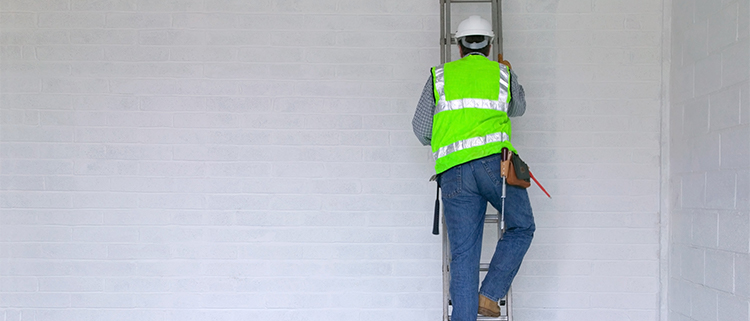
Everyone knows how to use a ladder. Of all the hazards your employees face on the job, ladders are among the least of their concerns, right?
Not necessarily. About 187,000 Americans are injured annually on ladders. Every year, more workers are injured in falls from ladders than from any other elevated surface.
If you train your employees to follow these three basic steps, you can help ensure they arrive back at ground level safely.
Step 1. Inspect the ladder:
- Ladders have a duty rating, which specifies the amount of weight it can support. This ranges from Type III (200 pounds) to Type IAA (375 pounds). The ladder’s rating should be listed on a specifications label on the side rail.
- Rails are strong and undamaged.
- Rungs and steps are solid, undamaged and free of oil, grease and dirt.
- Fittings are tight.
- Spreaders and other locking devices are in place.
- Non-skid safety feet are in place.
- No structural defects.
- All support braces are intact.
Step 2. Set up the ladder properly:
- Choose a clean, slip-free, level surface.
- Use the 4-to-1 rule, placing the ladder base 1/4 the height of the ladder from the wall when using an extension ladder. For example, if your ladder is 8 feet tall, the base should be 2 feet from the wall.
- A straight or extension ladder should extend 3 feet beyond the level it is being used to reach when stepping off. For example, if you are using a ladder to access a roof, your ladder should extend three feet higher than the roof.
- Secure or tie the extension ladder to prevent slippage. Have a second person hold the bottom of the ladder whenever possible.
Step 3. Use the ladder safely:
- Face the ladder.
- Use both hands.
- Wipe dirt and grease from your hands and shoes.
- Never allow more than one person on a ladder.
- Use carriers and tool belts to carry objects up a ladder.
- Do not lean out from the ladder.
- Never shift the ladder while your weight is on it.
- See manufacturer label for maximum rung height to work safely from.
- If you are afraid of heights, don’t climb a ladder.
- Maintain 3-point contact at all times: one foot and two hands, or two feet and one hand on the ladder
Texas Mutual policyholders can get free materials on ladder safety in their Texas Mutual account. Or, visit the Occupational Safety and Health Administration for free resources.